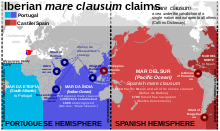Treaty of Tordesillas
That line of demarcation was about halfway between Cape Verde (already Portuguese) and the islands visited by Christopher Columbus on his first voyage (claimed for Castile and León), named in the treaty as Cipangu and Antillia (Cuba and Hispaniola).[6] The Treaty of Tordesillas was intended to solve the dispute that arose following the return of Christopher Columbus and his crew, who had sailed under the Crown of Castile.After learning of the Castilian-sponsored voyage, the Portuguese King sent a threatening letter to the Catholic Monarchs, King Ferdinand and Queen Isabella, stating that by the Treaty of Alcáçovas signed in 1479 and by the 1481 papal bull Aeterni regis that granted all lands south of the Canary Islands to Portugal, all of the lands discovered by Columbus belonged, in fact, to Portugal.The Portuguese king also stated that he was already making arrangements for a fleet (an armada led by Francisco de Almeida) to depart shortly and take possession of the new lands.[7] The Spanish rulers replied that Spain owned the islands discovered by Columbus and warned King John II not permit anyone from Portugal to go there.Finally, the rulers invited Portugal to send ambassadors to begin diplomatic negotiations aimed at settling the rights of each nation in the Atlantic.Another bull, Dudum siquidem, entitled Extension of the Apostolic Grant and Donation of the Indies and dated 25 September 1493, gave all mainlands and islands, "at one time or even still belonging to India" to Spain, even if east of the line.[citation needed] The Portuguese King John II was not pleased with that arrangement, feeling that it gave him far too little land—it prevented him from possessing India, his near-term goal.As one scholar assessed the results, "both sides must have known that so vague a boundary could not be accurately fixed, and each thought that the other was deceived", concluding that it was a "diplomatic triumph for Portugal, confirming to the Portuguese not only the true route to India, but most of the South Atlantic".[23] But Portugal's discovery of the highly valued Moluccas in 1512 caused Spain to argue in 1518[citation needed] that the Treaty of Tordesillas divided the earth into two equal hemispheres.The Treaty of Vitoria, negotiated between Spain and Portugal on 19 February 1524, called for the Junta of Badajoz to meet in an attempt to reach an agreement on the anti-meridian, which ultimately failed.[citation needed] Portugal gained control of all lands and seas west of the Zaragoza line, including all of Asia and its neighboring islands so far discovered, leaving Spain most of the Pacific Ocean.





Treaty of Tordesillas (1524)TordesillasRatifiedPope Julius IIFerdinand II of AragonIsabella I of CastileJohn, Prince of AsturiasJohn II of Portugalpapal bullSetúbalKingdom of PortugalCrown of CastilemeridianCape VerdeChristopher ColumbusCipanguAntilliaHispaniolaPope Alexander VITreaty of ZaragozaUNESCOMemory of the World ProgrammeGeneral Archive of the IndiesTorre do Tombo National ArchiveKing John IICatholic MonarchsFerdinandIsabellaTreaty of AlcáçovasAeterni regisFrancisco de AlmeidaPope Alexander VIRodrigo BorgiaAragoneseValenciaInter caeteraAzoresDudum siquidemCape of Good HopeleaguesAfricaMare clausumAge of DiscoveryPope Julius IIEa quae pro bono pacisPedro Álvares CabralCape São RoquePortuguese India ArmadasVasco da GamaManila-Acapulco galleonsPortuguese expansion of BrazilBrazilianHarrisseCantino planisphereCasa da ÍndiaPadrão RealDiogo RibeiroPadrón Realspecifically measured leagueGreenwichstadesPortuguese standard mapAmazon RiverBaía de São MarcosMearimMartin Fernández de EncisopilotsSebastian CabotJohn CabotJuan VespucciAmerigo Vespucciconference at BadajozSpanish milesSanto AntãoCharles IEmperor Charles VJohn III of PortugalSpanish standard mapMoluccasMagellanducatsIndonesianarchipelagoMaluku IslandsclovesHalmaheraTernateTidoreMakianForte de São João Baptista de TernatePetrus PlanciusLinschotenMariana IslandsHokkaidōNew SpainPhilip IIMiguel López de LegazpiAndrés de UrdanetaBrazilAngolaMozambiquePortuguese GuineaSão Tomé and PríncipeMuscatBahrainBombayDaman and DiuCeylonMalaccaMakassarPortuguese TimorentrepôtDejimaNagasakiFormosaPortuguese EmpireSpanish EmpireIberian UnionFrancis ITreaty of Madrid (13 January 1750)King John V of PortugalFerdinand VI of Spaincolony of Sacramentoleft bankRiver PlataSeven Missions

